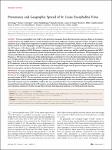Provenance and Geographic Spread of St. Louis Encephalitis Virus
Kopp, Anne
Gillespie, Thomas R.
Hobelsberger, Daniel
Estrada, Alejandro
Harper, James M.
Miller, Richard A.
Eckerle, Isabella
Müller, Marcel A.
Podsiadlowski, Lars
Leendertz, Fabian
Drosten, Christian
Junglen, Sandra
St. Louis encephalitis virus (SLEV) is the prototypic mosquito-borne flavivirus in the Americas. Birds are its primary vertebrate hosts, but amplification in certain mammals has also been suggested. The place and time of SLEV emergence remain unknown. In an ecological investigation in a tropical rainforest in Palenque National Park, Mexico, we discovered an ancestral variant of SLEV in Culex nigripalpus mosquitoes. Those SLEV-Palenque strains form a highly distinct phylogenetic clade within the SLEV species. Cell culture studies of SLEV-Palenque versus epidemic SLEV (MSI-7) revealed no growth differences in insect cells but a clear inability of SLEV-Palenque to replicate in cells from birds, cotton rats, and free-tailed bats permissive for MSI-7 replication. Only cells from nonhuman primates and neotropical fruit bats were moderately permissive. Phylogeographic reconstruction identified the common ancestor of all epidemic SLEV strains to have existed in an area between southern Mexico and Panama ca. 330 years ago. Expansion of the epidemic lineage occurred in two waves, the first representing emergence near the area of origin and the second involving almost parallel appearances of the virus in the lower Mississippi and Amazon delta regions. Early diversification events overlapped human habitat invasion during the post-Columbian era. Several documented SLEV outbreaks, such as the 1964 Houston epidemic or the 1990 Tampa epidemic, were predated by the arrival of novel strains between 1 and 4 years before the outbreaks. Collectively, our data provide insight into the putative origins of SLEV, suggesting that virus emergence was driven by human invasion of primary rainforests. IMPORTANCE St. Louis encephalitis virus (SLEV) is the prototypic mosquito-transmitted flavivirus of the Americas. Unlike the West Nile virus, which we know was recently introduced into North America from the Old World, the provenience of SLEV is obscure. In an ecological investigation in a primary rainforest area of Palenque National Park, Mexico, we have discovered an ancestral variant of SLEV. The ancestral virus was much less active than the epidemic virus in cell cultures, reflecting its incomplete adaptation to hosts encountered outside primary rainforests. Knowledge of this virus enabled a spatiotemporal reconstruction of the common ancestor of all SLEVs and how the virus spread from there. We can infer that the cosmopolitan SLEV lineage emerged from Central America in the 17th century, a period of post-Columbian colonial history marked by intense human invasion of primary rainforests. Further spread followed major bird migration pathways over North and South America.
Dateien zu dieser Publikation
Keine Lizenzangabe
Verwandte Publikationen
Anzeige der Publikationen mit ähnlichem Titel, Autor, Urheber und Thema.
-
2014-05-12ZeitschriftenartikelTick-Borne Encephalitis Virus Replication, Intracellular Trafficking, and Pathogenicity in Human Intestinal Caco-2 Cell Monolayers Yu, Chao; Achazi, Katharina; Möller, Lars; Schulzke, Jörg D.; Niedrig, Matthias; Bücker, RolandTick-borne encephalitis virus (TBEV) is one of the most important vector-borne viruses in Europe and Asia. Its transmission mainly occurs by the bite of an infected tick. However, consuming milk products from infected ...
-
2010-06-30ZeitschriftenartikelConfirmed Exposure to Tick-Borne Encephalitis Virus and Probable Human Cases of Tick-Borne Encephalitis in Central/Northern Anatolia, Turkey Ergünay, Koray; Saygan, Mehmet B.; Aydoğan, Sibel; Litzba, Nadine; Sener, B.; Lederer, Sabine; Niedrig, Matthias; Hasçelik, G.; Us, DürdalTick-borne encephalitis virus (TBEV) is the aetiological agent of tick-borne encephalitis (TBE), a potentially fatal central nervous system infection of humans. TBE is endemic in many areas of Europe and Asia; however, ...
-
2011-05-06ZeitschriftenartikelRodents as Sentinels for the Prevalence of Tick-Borne Encephalitis Virus Achazi, Katharina; Ruzek, Daniel; Mantke, Oliver Donoso; Schlegel, Mathias; Ali, Hanan Sheikh; Wenk, Mathias; Schmidt-Chanasit, Jonas; Ohlmeyer, Lutz; Rühe, Ferdinand; Vor, Torsten; Kiffner, Christian; Kallies, René; Ulrich, Rainer; Niedrig, MatthiasIntroduction: Tick-borne encephalitis virus (TBEV) causes one of the most important flavivirus infections of the central nervous system, affecting humans in Europe and Asia. It is mainly transmitted by the bite of an ...

